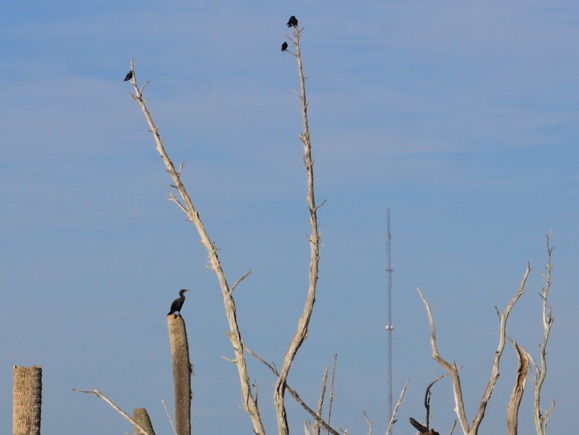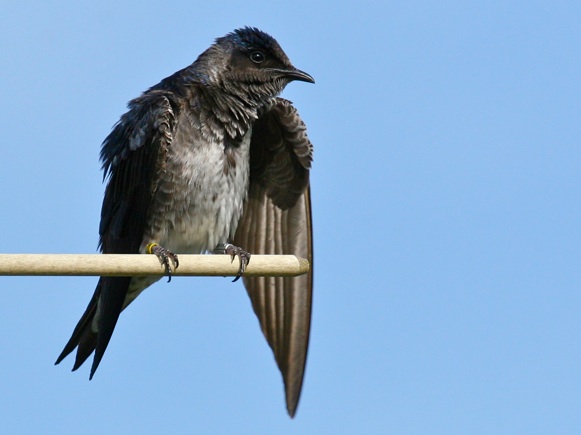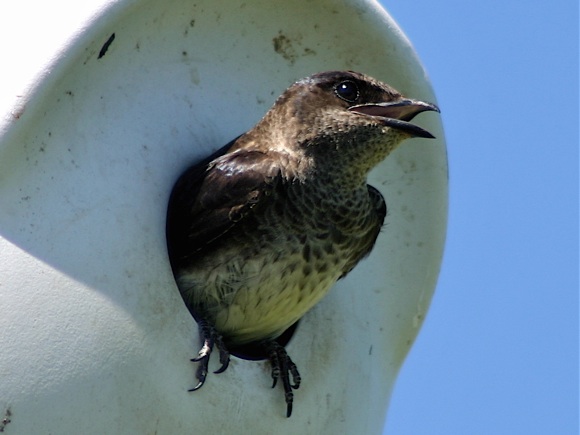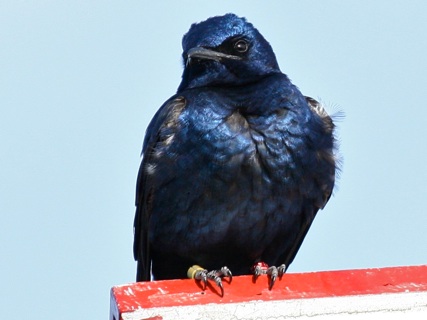The Nature
Observer’s Journal
The Nature
Observer’s Journal

A Unique Purple Martin Colony
Chuck Tague
For a moment a Purple Martin appeared to hang over the birders as if he were suspended on a string. The birders were part of the Halifax River Audubon Society’s field trip to Orlando Wetlands Park near Christmas, Florida. The martin, an adult male, sang his liquid gurgle then swerved high and away. It was only February 5 but he had already traveled thousands of miles from his winter grounds somewhere in Brazil’s lower Amazon basin. The spring vanguard arrives in Florida in mid January. Martins had been reported for over a week. (The first martins don’t arrive in Pennsylvania until early April.)
The 1,650 acre wetlands park is maintained by the city of Orlando. Although its primary function is a wastewater treatment facility, it is a prime birding spot with a significant ornithological distinction. It is the only place in eastern North America where Purple Martins nest in natural cavities.

Two Purple Martins and a European Starling at Orlando Wetlands. Although the martins nest like they did long ago, signs of the modern world are very evident.
The martin glided across the pond and landed near a female and three other males in a cluster of dead trees. The trees, mostly Sabal Palms, stand among thick spatterdock and other floating vegetation. Their trunks are riddled with woodpecker holes. In a few weeks the ponds will swarm with dragonflies, damselflies and other insects. It’s an ideal location for a martin colony. They have nested in the palms since 1993.

The Purple Martin is the largest of the North American swallows. All martins east of the Rocky Mountains are colonial cavity nesters. They originally nested in woodpecker holes on rivers floodplains but they long ago formed a mutual association with humans. Native Americans hung hollow gourds around their villages to attract these entertaining, insect-consuming birds. European settlers adopted the practice but replaced gourds with more elaborate containers like ceramic bottles and wooden bird houses. Building fancy martin houses was an art in early America. Audubon noted that most taverns had them above their signs; the quality of the martin house reflected the quality of the establishment.

By 1900 the eastern Purple Martin had almost completely abandoned natural cavities for human-supplied structures. Before the martins settled in at Orlando Wetlands Park there were no known “natural” martin colonies in eastern North America. In an interesting contrast of life-styles, the western Purple Martin, a different subspecies, is not a colonial nester and only uses woodpecker cavities in trees and cacti.

Purple Martins are a passion with many birders. The Purple Martin Conservation Association estimates over one million North Americans put up martin houses. Orlando Wetlands is the only place, however, to observe these birds as they lived in wild America.
For more information on Purple Martins, or to learn how to become a martin “landlord” contact the Purple Martin Conservation Association.
You can also listen to Purple Martin vocalizations on the PMCA website.
View more Purple Martin photos in the Nature Observer Gallery.
Send comments to The Nature Observer.
Saturday, February 5, 2011

A Purple Martin lands on a martin house.